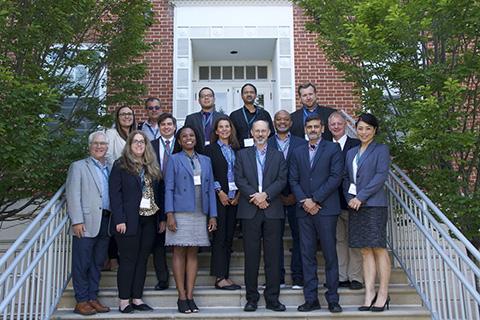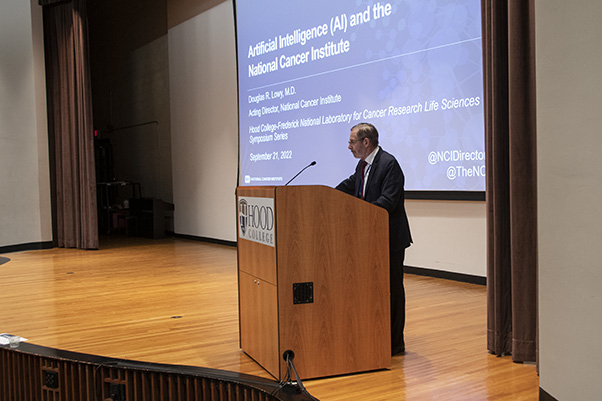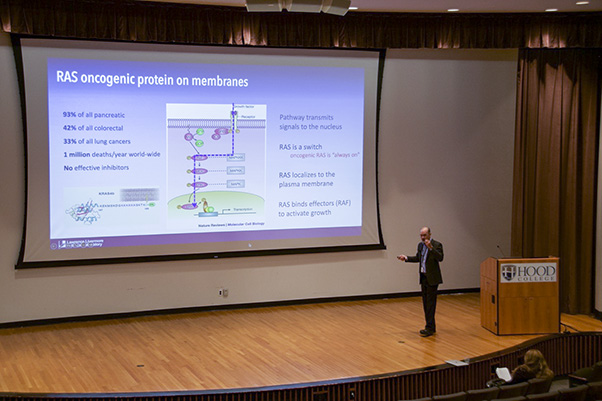Late last year, some of the world’s top leaders in the field came together to discuss the progress of artificial intelligence (AI) applications in cancer research and clinical care at a scientific symposium hosted by Hood College and Frederick National Laboratory.
It was one of several large scientific gatherings in Frederick in 2022 with implications for the new year and beyond. AI in Cancer Research and Clinical Care: Turning Promise into Reality proved to be a meeting not just between experts but also between disciplines, old and new traditions, and past accomplishments and future trends.
Participants came from more than 30 institutions across the U.S. and Canada, including multiple Historically Black Colleges and Universities. Lectures showcased cancer patient digital twins, ethical use of AI, clinical adoption, ways to reduce biases in data, and methods for engaging AI to address cancer health disparities.
Two other items, the protection of patient privacy and the lack of but importance of demographically diverse data, also proved to be big talking points.
“It was intentionally intersectional, focusing on bringing different perspectives together,” said Eric Stahlberg, Ph.D., director of cancer data science initiatives at FNL and a symposium co-organizer.
Connections and Intersections Abound
AI is a field that combines large quantities of data with powerful computer algorithms to accomplish specific tasks.
In science and medicine, AI makes it possible to perform analyses and reach conclusions that wouldn’t be practical for humans to do themselves. A cancer patient digital twin, for instance, is a computerized model of an individual cancer patient, based on their own biological data, that doctors can use to study, test, and predict how different treatments would affect the patient’s cancer.
But biomedical AI is still an emerging field. If computational scientists, life scientists, and physicians are to deploy it to help cancer patients, they must combine their expertise. Unsurprisingly, there’s an abundance of the intersections Stahlberg mentioned.
“It’s really important to bring all of the perspectives together,” Stahlberg said. “In so many situations, we can get focused into our own areas, but then we begin to have less appreciation for those complementary areas which are still part of the overall whole ecosystem.”
Keynote speaker Keith Yamamoto, Ph.D., president of the American Association for the Advancement of Science, underscored that theme during the symposium.
“Biomedical research, clinical and social research, together, are at an inflection point,” he said to those gathered. Traditional, siloed approaches have enabled substantial progress. However, he added that a future awaits where the disciplines can be more potently integrated, driven by AI.
The solution for crossing the gulf? Merge the sciences and build a system for AI to learn, said Yamamoto, who is also a vice chancellor, vice dean, and professor at University of California, San Francisco.
“I hope you can appreciate the fact that the opportunity is there and your responsibilities for doing it right are going to impact the rest of our big fields, … and so I’m really excited that you’re doing that, that this group is putting some thought into it,” he told symposium attendees.
As an example of how AI can be brought to bear, Yamamoto cited an AI network at University of California, San Francisco, that identified a vulnerability in ventilator treatment for SARS-CoV-2, allowing researchers to propose a solution that soon became standard of care. Another effort using the same network predicts multiple sclerosis in at-risk people years before it manifests.
Both projects involved collaboration between partners from multiple disciplines.
Consequently, achieving similar success in using AI against cancer depends on clear communication between interdisciplinary partners, said symposium co-organizer and FNL Chief Science Officer Leonard Freedman, Ph.D. With the diversity of fields involved, experts face the challenging task of finding a common language that all collaborators can understand.
Based on what he saw at the symposium, Freedman remains optimistic.
“We hit this really nice combination of data scientists, bioinformaticians, and hands-on clinicians who really, to their credit, went a long way to being able to communicate with each other,” he said.
As the field develops, another hope is that this diversity will reduce blind spots. Collaborators’ data and AI tools, when combined across disciplines, could fill gaps and identify biases and flaws in models and information. Meanwhile, data obtained from diverse patient populations would make findings more relevant to multiple demographics, including traditionally underrepresented groups.
Forward from the Past
The symposium was the second hosted by Hood and FNL in recent years, part of a partnership to recreate gatherings in the spirit of the popular NCI–Hood College Oncogene Meetings in line with FNL’s mission to connect scientists and the community in meaningful ways. The Oncogene Meetings were held annually from 1984–2004 and, like the AI symposium, sought to unite experts in an interdisciplinary effort to explore what was then an emerging field.
It’s impossible to predict whether Hood and FNL’s latest gatherings will also have a two-decade run, but it seems that the future impact of 2022’s symposium is already cemented. Stahlberg noted cross-disciplinary connections forming, and some participants asked when the next symposium will happen.
“We have to go all the way from the research to the full delivery … to have things be sustained and have an impact, and that’s what we were able to do with that meeting,” Stahlberg said.
Samuel Lopez leads the editorial team in Scientific Publications, Graphics & Media (SPGM). He writes for newsletters; informally serves as an institutional historian; and edits scientific manuscripts, corporate documents, and a slew of other written media. SPGM is the creative services department and hub for editing, illustration, graphic design, formatting, multimedia, and training in these areas.
Mary Ellen Hackett is the communications manager at Frederick National Laboratory, where she leads the Public Affairs and Communications Office. PACO supports FNL through external communications and community relations, internal business communications, and creative multimedia services.




